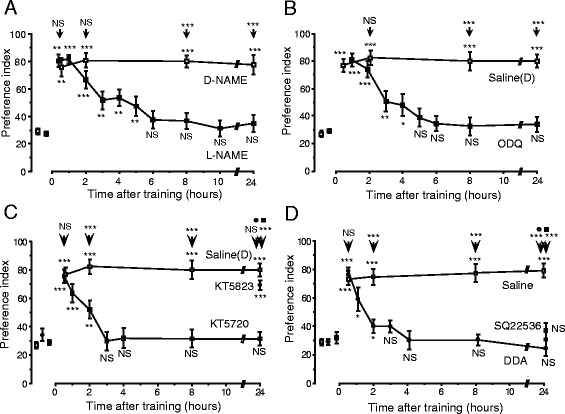Figure 6.

Effects of inhibitors of components of the NO-cGMP signaling pathway (A and B) and cAMP signaling pathway (C and D) on olfactory LTM formation. At 20 min prior to multiple-trial conditioning, animals were each injected with 3 μl of saline or saline containing various drugs. The preference indexes (PIs) before and at various times after conditioning are shown as means ± S. E. In (A), animals in ten experimental groups were each injected with the NOS inhibitor L-NAME (400 μM) (black squares) and animals in another four control groups were each injected with the inactive isomer D-NAME (400 μM) (open squares). In (B), animals in twelve groups were each injected with the sGC inhibitor ODQ (200 μM) dissolved in saline containing 0.1% DMSO (black squares), or saline containing 0.1% DMSO (saline (D) group, open squares). In (C), animals in twelve groups were each injected with the PKA inhibitor KT5720 (200 μM) (black squares), the cGMP-dependent protein kinase (PKG) inhibitor KT5823 (1 mM) (black circles), or saline containing 0.1% DMSO (open squares). In D, animals in twelve groups were each injected with the adenylyl cyclase inhibitor DDA (1 mM) (black circles), another adenylyl cyclase inhibitor, SQ22536 (1 mM) (black squares), or saline (open squares). PIs before conditioning are shown as pooled data from all experimental or control groups. Odor preferences were compared before and after conditioning for each group (Wilcoxon’s test) and between experimental and control groups at each time after conditioning (Mann-Whitney test), and the results are shown at each data point and above the arrow, respectively (*P < 0.05; **P < 0.01; ***P < 0.001; NS P < 0.05). Modified from Matsumoto et al. [32].
